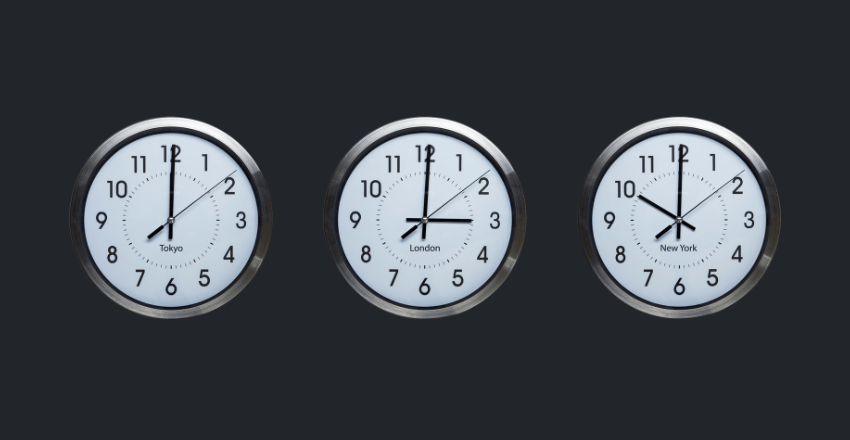Menu
 Dealing with Different Time Zones can prove to be a significant obstacle for global teams. With members dispersed across various time zones, coordinating meetings, managing deadlines, and ensuring seamless collaboration become complex tasks.
Dealing with Different Time Zones can prove to be a significant obstacle for global teams. With members dispersed across various time zones, coordinating meetings, managing deadlines, and ensuring seamless collaboration become complex tasks.
These hurdles can lead to delays, miscommunication, and decreased productivity. However, by implementing strategic scheduling, utilizing technology, and promoting flexible work practices, these challenges can be overcome.
Managing time zones can be a tricky business, especially when it comes to coordinating with remote teams or clients. With global business operations becoming increasingly common, time zone differences have become a significant concern for many professionals.
Table of Contents
Toggle| Topic | Key Points |
|---|---|
| Understanding time zones |
|
| Time differences |
|
| Time zone coordination |
|
| Overcoming challenges |
|
| Best practices |
|
| Tools and technologies | Scheduling apps, communication platforms, collaboration tools. |
| Time zone awareness in business |
|
| Enhancing productivity |
|
Dealing with different time zones can be a challenge, but it’s essential for effective collaboration and communication in today’s global business environment. Understanding how time zones work and the differences between them is key to successful time zone management.
Time zones are based on the concept of dividing the world into 24 longitudinal sections, each representing one hour of the day. They are centered on the Prime Meridian, which runs through Greenwich, England, and are measured in relation to Coordinated Universal Time (UTC).
There are 40 different time zones in the world, each with a unique offset from UTC. Some regions, such as the United States and Canada, have multiple time zones within their borders due to their vast size.
The time difference between two locations is determined by comparing their respective time zones and offsets. For example, if someone in New York City wants to schedule a meeting with a colleague in Tokyo, they would need to take into account the 13 hour time difference between the Eastern Time Zone (UTC-5) and Japan Standard Time (UTC+9).
Using a time zone converter can help ensure accurate scheduling across time zones. These tools allow you to easily compare the time differences between locations and convert meeting times into local time zones.
International time zones are designated by the International Date Line, which runs through the Pacific Ocean. Locations to the east of the line are one day ahead of those to the west.
It’s important to keep in mind that some locations, such as parts of Australia and the United States, observe daylight saving time (DST), which can further complicate time differences. DST is not observed in all regions of the world and the dates on which it begins and ends may vary, making time zone calculation even more challenging.
A solid understanding of time zones and time differences is crucial for successful time zone management. By utilizing time zone converters and other tools, you can effectively coordinate with team members and clients across the globe.
Working with team members or clients in different time zones presents a unique set of challenges. Time zone coordination is critical for effective collaboration and communication. Here are some strategies to help you navigate these challenges:
By following these strategies, you can effectively coordinate with team members in different time zones and ensure a productive and successful collaboration.

Dealing with different time zones can present various challenges, from scheduling meetings to meeting deadlines. However, there are strategies that can help you overcome these challenges and ensure productivity even when working with people in different time zones.
If possible, adjusting work hours to overlap with team members or clients in different time zones can be helpful. This may mean starting work earlier or staying later to accommodate time differences.
Clear communication about deadlines is crucial when working with people in different time zones. Make sure everyone understands the appropriate deadlines based on their local time and factor in any potential delays due to time differences.
Working across different time zones can make it difficult to establish a healthy work-life balance. It’s important to set clear boundaries and prioritize self-care to prevent burnout and maintain productivity.
Managing time zones efficiently can be challenging, but there are several best practices that can help remote teams work effectively across different time zones:
By implementing these best practices, remote teams can effectively manage time zones and work together efficiently, even when separated by large geographical distances.
Collaborating across different time zones can be a challenge, but there are various tools and technologies that can make it easier. Here are some examples:
| Tool/Technology | Description |
|---|---|
| Time Zone Converter | A tool that allows you to easily convert time zones and schedule meetings across different time zones. |
| Scheduling Apps | Apps like Calendly and Doodle that allow you to schedule meetings and events with people in different time zones. |
| Communication Platforms | Platforms like Zoom, Skype, and Slack that allow for real-time communication and collaboration across different time zones. |
| Collaboration Tools | Tools like Google Drive, Dropbox, and Trello that allow teams to collaborate on projects regardless of time zone differences. |
It’s important to choose tools and technologies that are easy for everyone on the team to use and that facilitate effective communication and collaboration.

In today’s globalized world, businesses often operate across different countries and time zones. It is essential to be aware of regional time differences to ensure effective communication and collaboration with colleagues and clients.
When working with teams in different regions, it is important to be mindful of cultural differences and working norms. Respect for local customs and practices can help build strong relationships and foster successful partnerships, regardless of the time zone differences.
There are 24 primary time zones in the world, each spanning 15 degrees of longitude. The time within each time zone is coordinated to within an hour or half-hour difference from Coordinated Universal Time (UTC).
It is crucial to understand the time zones where your clients or team members are located, especially when scheduling calls or meetings. Utilizing tools like time zone converters or scheduling apps can help avoid confusion and scheduling conflicts.
When working across different time zones, cultural sensitivity and understanding can go a long way in building successful relationships. Paying attention to regional customs and business practices can help avoid misunderstandings and build trust with clients or team members in different parts of the world.
It is also important to recognize that work-life balance may be viewed differently in different cultures. For example, in some Asian countries, long work hours are often the norm. Being aware of these differences can help you communicate effectively and respectfully with team members or clients in different regions.
When working across different time zones, communication can be a challenge. To ensure effective collaboration, it is essential to establish clear communication protocols and utilize tools that enable asynchronous communication, such as email or messaging apps.
It is also important to foster understanding and build relationships with team members or clients in different time zones. This can be achieved through regular check-ins and opportunities for virtual team building and socialization.
Overall, time zone awareness and cultural sensitivity are essential for success in global business. By understanding and respecting time zone differences, businesses can build strong relationships, enhance productivity, and promote successful collaboration with colleagues and clients around the world.
Working across different time zones can pose a challenge to productivity. However, with some planning and the right strategies, it is possible to work efficiently and achieve great results.
When collaborating across different time zones, it is important to identify the hours when team members are available simultaneously. This will allow for real-time communication, which can save time and prevent delays. Make sure to schedule important meetings and discussions during these overlap hours.
When working across time zones, it’s essential to set clear priorities and deadlines. Make sure all team members understand the importance of their tasks and when they are expected to deliver. Use project management tools to manage tasks, and set reminders to ensure that deadlines are met.
Asynchronous communication tools like email, project management software, and messaging apps can be valuable when working with colleagues across different time zones. Instead of waiting for real-time responses, use these tools to communicate updates, confirmations, and questions. This way, team members can respond when it is convenient for them without causing delays.
When working with colleagues across the globe, it’s important to be sensitive to cultural and personal differences. Foster a culture of understanding by acknowledging and respecting these differences. Encourage open communication and empathy, and create an inclusive working environment that values diversity.
It’s important to keep track of time differences between team members working in different time zones. Use time zone conversion tools and apps to ensure accurate scheduling and minimize confusion. Make sure to confirm the time zone of upcoming meetings and deadlines, and double-check the time difference if necessary.
By utilizing these strategies, you can enhance productivity and effectively collaborate with team members across different time zones. Remember that communication and planning are key to success, so make sure to prioritize both when working with remote colleagues.
Dealing with different time zones can be challenging, especially when it comes to managing your personal and professional life. Here are a few tips for balancing work and personal life when working across different time zones:
Remember, communication is key. Be transparent with your colleagues or clients about your availability and ask them to do the same. With good planning and healthy habits, you can maintain a healthy work-life balance even when dealing with different time zones.
When working with remote teams across different time zones, effective communication is crucial for maintaining productivity and ensuring everyone is on the same page. Here are some tips for improving time zone communication:
Set clear guidelines for communication, including preferred methods, response times, and expectations for availability. Everyone should understand how and when they are expected to communicate with team members in different time zones.
Asynchronous communication tools like email, instant messaging, and project management software can be extremely helpful for communicating with team members in different time zones. They allow everyone to communicate on their own schedule without disrupting others who may be sleeping or working.
Encourage team members to learn about each other’s cultures and time zone differences. This can help build empathy and respect, and improve communication overall.
When communicating with team members in different time zones, it’s important to be mindful of tone. Avoid using language that can be misinterpreted or come across as dismissive. Use a positive and respectful tone instead.
There are many time zone conversion tools available online that can help you find the best time for meetings or other collaborative work. Use these tools to simplify scheduling and ensure everyone is on the same page.
By following these tips, you can improve communication and collaboration with team members across different time zones, ultimately leading to more productive and successful remote work.
When managing a project with team members or clients located in different time zones, effective time zone management is crucial for ensuring smooth project execution. Here are some strategies and tips to help you manage time zone differences in project management:
It’s essential to have a clear understanding of the time differences between team members or clients in different time zones. This will help you schedule meetings and assign tasks more efficiently. Utilize a time zone converter tool to get an accurate understanding of the time differences.
Scheduling meetings can be one of the biggest challenges when working across different time zones. To overcome this, schedule meetings during overlapping work hours as much as possible. Also, consider rotating meeting times to accommodate everyone’s schedules fairly.
Asynchronous communication channels, such as email or messaging platforms, can be useful for team members or clients who are not available during overlapping work hours. Utilize these channels to facilitate communication and ensure all team members are informed and updated on project progress.
When working across different time zones, it’s essential to set clear expectations and deadlines for tasks and deliverables to avoid misunderstandings and delays. Ensure all team members are aware of the project timeline and their individual roles and responsibilities, and establish a protocol for updates and progress reports.
Effective communication and collaboration are essential for project success when working across different time zones. Ensure all team members have access to the necessary communication and collaboration tools, and encourage open communication and collaboration across the team.
By implementing these strategies and tips, you can effectively manage time zone differences in project management and ensure smooth project execution.

Dealing with different time zones can be a challenge, but with the right strategies and tools, it can be manageable and even enjoyable. Below are some frequently asked questions about time zone management and solutions to overcome these challenges.
A: There are many time zone converter tools available online that can help you determine the current time in any location. You may also use your smartphone’s clock app or ask Siri or Google Assistant for the current time in a specific time zone.
A: Use a scheduling app that can take into account the time zone differences and find the best times that work for everyone. Make sure to communicate clearly about the time zone of the meeting and use a time zone converter to ensure everyone understands the correct meeting time in their timezone.
A: Try to be flexible and find a schedule that works for both you and your team or clients in different time zones. Consider adjusting your work hours to overlap with the most important time zones or create a work schedule based on the time zones you work with the most.
A: Set boundaries for your work hours and make sure to take breaks throughout the day. Communicate clearly with your team or clients about your availability and make sure to prioritize self-care and personal responsibilities outside of work.
A: Establish clear communication protocols and use asynchronous communication tools like email or project management software to communicate across time zones. Foster understanding among team members by taking the time to learn about their culture and time zone differences.
A: There are many tools available to help with time zone management, including time zone converters, scheduling apps, and communication platforms. Find the ones that work best for your team’s needs and utilize them consistently for efficient time zone management.
With these tips and solutions, dealing with different time zones can be a manageable task that helps you work effectively with a global team and make the most out of remote collaboration.
About the author: Jacob Tenwick
Avid business developer and development manager
Input your search keywords and press Enter.